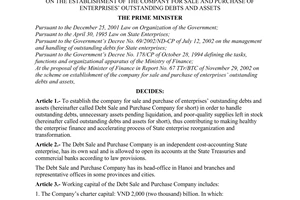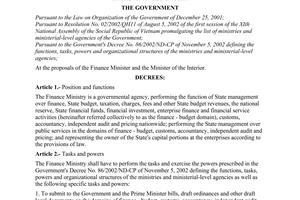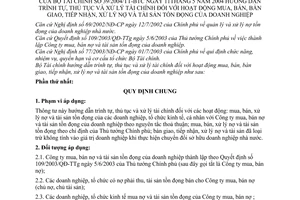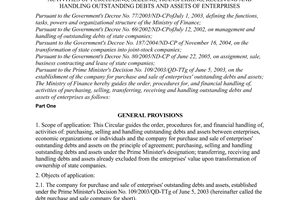Circular No. 39/2004/TT-BTC of May 11, 2004 guiding the order, procedures for, and financial handling of, activities of purchasing, selling, delivering, receiving and handling enterprises' outstanding debts and assets đã được thay thế bởi Circular No. 38/2006/TT-BTC of May 10, 2006, guiding the order, procedures for, and financial handling of, activities of purchasing, selling, transferring, receiving and handling outstanding debts and assets of enterprises. và được áp dụng kể từ ngày 08/06/2006.
Nội dung toàn văn Circular No. 39/2004/TT-BTC of May 11, 2004 guiding the order, procedures for, and financial handling of, activities of purchasing, selling, delivering, receiving and handling enterprises' outstanding debts and assets
|
THE
MINISTRY OF FINANCE |
OF VIET |
|
, May 11, 2004 |
CIRCULAR
GUIDING THE ORDER, PROCEDURES FOR, AND FINANCIAL HANDLING OF, ACTIVITIES OF PURCHASING, SELLING, DELIVERING, RECEIVING AND HANDLING ENTERPRISES' OUTSTANDING DEBTS AND ASSETS
Pursuant to the Government's Decree
No. 69/2002/ND-CP of July 12, 2002 on management and handling of outstanding
debts of State enterprises;
Pursuant to the Prime Minister's Decision No. 109/2003/QD-TTg of June 5, 2003
on establishment of the company for purchase and sale of enterprises'
outstanding debts and assets;
Pursuant to the Government's Decree No. 77/2003/ND-CP of July 1, 2003 defining
the functions, tasks, powers and organizational structure of the Ministry of
Finance;
The Ministry of Finance hereby guides the order, procedures for, and financial
handling of, activities of purchasing, selling, delivering, receiving, and
handling enterprises' outstanding debts and assets as follows:
Part One
GENERAL PROVISIONS
1. Scope of application: This Circular guides the order, procedures for, and financial handling of, activities of: purchasing, selling and handling outstanding debts and assets between enterprises, economic organizations, individuals and the company for purchase and sale of enterprises' outstanding debts and assets on the principle of negotiation; purchasing, selling and handling outstanding debts and assets under the Prime Minister's mandate; delivering, receiving and handling debts and assets already excluded from the enterprises' value upon transformation of ownership of State enterprises.
2. Objects of application:
2.1. The company for purchase and sale of enterprises' outstanding debts and assets, established under the Prime Minister's Decision No. 109/2003/QD-TTg of June 5, 2003 (herein after called the debt purchase and sale company for short).
2.2. Enterprises and organizations having receivable debts, outstanding assets sold to the debt purchase and sale company (creditors, asset owners);
2.3. Enterprises and economic organizations purchasing outstanding debts and assets of the debt purchase and sale company;
2.4. Enterprises, organizations and individuals having payable debts (debtors);
2.5. Enterprises and economic organizations keeping others' debts and/or assets excluded from the enterprises' value upon transformation of ownership of State enterprises.
3. The terms used in this Circular are construed as follows:
3.1. "Outstanding debts" mean receivable or payable debts which have become overdue but not yet received or paid.
3.2. "Creditors" mean enterprises or organizations having receivable debts.
3.3. "Debtors" mean enterprises, organizations or individuals having payable debts.
3.4. "Asset owners" mean enterprises or organizations having the right to own assets.
3.5. "Outstanding assets" mean finished products, supplies, goods, fixed assets under the ownership of enterprises, which are left in stock but not needed by the enterprises.
3.6. "Purchase, sale of outstanding debts, assets" mean the sale by creditors of receivable debts or by owners of outstanding assets to the debt purchase and sale company which, as a result, becomes the new creditor of debtors or new owner of assets.
3.7. "Purchase, sale of outstanding debts, assets under mandate" means the purchase, sale of outstanding debts, assets under the Prime Minister's mandate.
4. The debt purchase and sale company shall be entitled to purchase, sell or handle outstanding debts, assets, including the value of land use rights, with prices agreed upon or mandated; to sell assets mortgaged or pledged for debts which it has bought, including the value of land use rights, according to current regulations.
5. Enterprises and organizations of all economic sectors shall be entitled to purchase, sell outstanding debts and assets at the agreed prices to the debt purchase and sale company.
6. When their contracts for purchase and sale of outstanding debts, assets become effective, the involved parties shall have the following rights and obligations:
- All the rights and obligations of the creditors (the debt sellers), the asset owners (the asset sellers) are transferred to the debt purchase and sale company.
- The creditors, asset owners shall have to fully transfer debts, assets together with the related dossiers and documents in strict accordance with the contracts and current law provisions and also to inform the debtors of the change of creditors of the sold debts.
- The debt purchase and sale company shall fully inherit the rights and obligations of the creditors towards the purchased debts, have the rights and obligations of asset owners towards the purchased assets.
- The debtors shall have to fulfill the debt repayment and other obligations towards the debt purchase and sale company (such as supplying documents and information related to their debts).
7. For outstanding debts, assets it has purchased or those assigned by the State to it for handling, the debt purchase and sale company may handle them in the following forms: recovering debts, selling security assets; leasing outstanding assets; using outstanding debts, assets for contribution of equities, joint-venture and/or business cooperation capital; selling outstanding debts, assets; repairing, upgrading outstanding assets for sale, lease, contribution of equities, joint-venture and/or business cooperation capital; or in other forms not banned by law. The outstanding debts and assets-handling order, procedures and competence of the debt purchase and < span="">is specified by the Minister of Finance in the Regulation on financial handling of the debt purchase and sale company.
8. Activities of purchasing and selling outstanding debts and assets must be recorded in vouchers according to current regulations.
9. Debt purchasers shall have to monitor and account the expenses for purchasing outstanding debts and/or assets according to prices (including prices of purchasing debts, prices of purchasing outstanding assets recorded in vouchers, expenses for asset transportation, < p="">
10. When purchasing outstanding debts, assets of the debt purchase and < span="">, enterprises and/or economic organizations shall comply with the market prices in the forms of negotiation, auction or bidding according to current regulations. The order, procedures and financial handling shall be the same as those applicable to the debt purchase and sale company's activities of selling outstanding debts and assets.
11. Activities of purchasing, selling, recovering and handling outstanding debts, also including selling mortgaged and pledged assets in order to recover debts as prescribed in this Circular, shall not be subject to value-added tax.
Part Two
SPECIFIC PROVISIONS
I. FOR ACTIVITIES OF PURCHASING, SELLING OUTSTANDING DEBTS AND ASSETS THROUGH NEGOTIATIONS
1. Order, procedures for purchasing, selling outstanding debts and assets
1.1. The debt purchase and < span="">and creditors having outstanding debts shall actively approach each other to know about each other's debt-purchasing and selling needs. When having the need to sell debts, creditors shall supply documents related to such debts to the debt purchase and sale company.
1.2. The purchase and sale of debts shall be < p="">
1.3. The purchase and sale of outstanding debts and assets shall be made at the market prices through negotiation, auction or bidding according to current regulations.
2. Financial handling of activities of debt-purchasing, -selling and -handling activities
2.1. For the debt purchase and sale company:
The purchased debts shall be regarded as a special type of goods. Revenues, expenses, and business results related to debt-purchasing and selling activities is prescribed in the Financial Regulation of the debt purchase and sale company.
2.2. For debt sellers
a/ Where the sold debts are receivable debts which are irrecoverable, have been handled by the creditors according to the State's regulations and are being monitored in out-of-the balance sheet accounts, the proceeds from the sale of these debts shall be accounted into the sellers' other incomes.
b/ Where the sold debts are debts being monitored in the accounting balance sheets, the proceeds from the sale thereof shall not be accounted into the debt sellers' revenues or other incomes but recorded as decreases in the corresponding receivable amounts. The negative difference between the proceeds from the sale of debts and the value of such debts recorded in the accounting books shall be offset with the following sources in the following order:
- The reserve for bad receivables or the risk reserve (for credit institutions).
- If the reserve for bad receivables or the risk reserve is not enough for offsetting, the deficit shall be accounted into business operation costs.
+ For State enterprises: In cases of accounting it into business operation costs for 02 (two) consecutive years, if the enterprises suffer from losses and are incapable of offsetting but do not yet fall into the cases of dissolution or bankruptcy, the enterprises shall compile dossiers to report thereon to competent State bodies for consideration and decision to reduce the State's capital in the enterprises according to current regulations.
+ For State enterprises which are undergoing ownership transformation: In cases of accounting into business costs, if they suffer from losses, the State's capital in the enterprises may be subtracted to offset the losses before the enterprises are transformed.
2.3. For debtors
After fully paying debts, if the actually paid amounts, which are accepted by the debt purchase and < span="">, are lower than the value of the debts accounted in the accounting books, the difference may be accounted into other incomes.
If the actual value of debts contributed as equities or joint-venture or business cooperation capital, which is accepted by the debt purchase and sale company, is lower than the value of the debts accounted in the accounting books, the difference may be accounted into other incomes.
3. Financial handling of activities of purchasing and selling outstanding assets
3.1. For the debt purchase and sale company:
The purchased debts shall be regarded as a special type of goods. Revenues, expenses, and business results related to asset-purchasing and -selling activities is prescribed in the Financial Management Regulation of the debt purchase and sale company.
3.2. For the asset sellers being enterprises:
- The enterprises may sell assets which they do not need to use or which are technically obsolete in order to recover capital for use for more efficient business purposes. Particularly for State enterprises, the competence to decide to sell assets and the procedures for selling assets shall comply with the State's current regulations.
- The proceeds from the sale of assets, minus the sale expenses, must be capitalized (the residual value of assets in the accounting books). Where the proceeds from the sale of assets (minus the sale expenses) are bigger than the residual value of assets in the accounting books, the positive difference may be accounted into the enterprises' incomes. If smaller, the negative difference shall be accounted into the enterprises' expenditures.
II. FOR ACTIVITIES OF PURCHASING AND SELLING OUTSTANDING DEBTS AND ASSETS UNDER MANDATE
1. Subjects entitled to sell outstanding debts and assets under mandate
1.1. Equitized State enterprises where the value of the State capital portions is not enough for clearance of accumulated losses and irrecoverable debts or where the value of the State capital portions, after being reduced, is not enough to ensure the compulsory percentage of State capital in the new joint-stock companies according to the approved plans in compliance with current regulations.
1.2. State enterprises which need to be maintained with 100% of State capital according to the Prime Minister-approved enterprise reorganization, renewal and development schemes but suffer from losses, are incapable of paying debts, and have outstanding debts and assets arising due to the following causes:
- Execution of decisions of competent State bodies.
- Changes in the State's mechanisms and policies, which directly affect the enterprises.
- Other objective and force majeure causes, such as natural calamities, epidemics.
1.3. Other subjects as decided by the Prime Minister.
2. Order and procedures for purchase and sale of debts and assets under mandate
2.1. Enterprises having outstanding debts and assets and falling into the subjects defined at Point 1, Section II, Part Two of this Circular shall have to compile dossiers related to their outstanding debts and assets, each consisting of:
- A report on the handling of outstanding debts, assets, clearly stating the reasons for the proposal to sell outstanding debts, assets under mandate.
- The efficient business plan approved by a competent authority (for case 1.2 in Section II).
- The written record on the valuation of the enterprise before transformation, made by the enterprise valuation council (for case 1.1 in Section II).
- Documents related to outstanding debts and assets, such as the competent agencies' decisions related to outstanding debts, assets, economic contracts, debt comparison reports, land use right certificates'
- The financial statements (of the latest three years).
2.2. The dossiers shall be sent the representatives of owners of the enterprises (ministers, heads of ministerial-level agencies, presidents of People's Committees of the provinces or centrally-run cities, managing boards of State corporations) and the Ministry of Finance.
2.3. Within 45 days as from the date of receiving the dossiers, the representatives of owners of the enterprises shall assume the prime responsibility for, together with the concerned functional bodies, determining the selling prices of outstanding debts and < p="">
2.4. Basing themselves on the decisions on purchase of debts and assets under mandate, the debt purchase and < span="">and the enterprises having outstanding debts and assets shall sign contracts on purchase and sale of debts and assets according to regulations.
2.5. The debt purchase and sale company shall have to organize the handling of outstanding debts and assets purchased under mandate through negotiation, auction or bidding according to current regulations and the guidance in its Financial Regulation.
If any assets purchased under mandate need to be repaired or upgraded in order to increase their value and create favorable conditions for the handling thereof for capital recovery, the debt purchase and < span="">shall repair, upgrade such assets with their own capital. If the repair or upgrading of assets is estimated to cost VND one billion or more, the debt purchase and sale company must work out repair or upgrading plans and submit them to the Ministry of Finance for consideration and decision before implementation.
Where after 02 (two) years as from the time of purchase of debts or assets, though having applied all measures and forms of recovering such debts or selling such assets, the debt purchase and sale company cannot recover or sell them, it shall send reports thereon to the Minister of Finance for handling plans.
3. Financial handling of activities of purchasing, selling outstanding debts and assets under mandate
3.1. For the debt purchase and sale company
- When purchasing outstanding debts and assets under mandate, the debt purchase and sale company shall be allocated by the Ministry of Finance money from the fund for State enterprise renewal in order:
+ To make payments to the sellers according to the prices under the mandate plans after the two parties sign purchase and sale contracts.
+ To cover expenses for operation, reception and management of outstanding debts and assets, which are equal to 1% of the value of such outstanding debts, assets according to the prices under the mandate
- The value recovered from the debts (from the recovery of debts from customers, sale of security assets or sale of debts), the proceeds from the sale of outstanding assets shall be handled as follows:
+ To cover expenses for repair or upgrading of assets (if any).
+ To subtract 10% of the money recovered from debts and the proceeds from the sale of assets for the debt purchase and sale company to cover valuation and/or auction expenses (if any) and to encourage the quick and efficient handling of outstanding debts and assets purchased under mandate in order to recover capital for the State.
+ To remit the remainder into the State budget (the fund for State enterprise reform).
- Where the debt purchase and sale company converts outstanding debts and assets into contributed equities, joint-venture or business cooperation capital, the value of such contributed capital, minus expenses for repair or upgrading of assets and valuation expenses (if any), shall be recorded as increases in the State capital allocated for the debt purchase and sale company's operation.
- Quarterly, the debt purchase and sale company shall report to the Ministry of Finance on the results of purchase, sale and handling of outstanding debts and assets under mandate.
3.2. For enterprises selling outstanding debts and assets
For enterprises selling outstanding debts and assets, the financial handling shall comply with the provisions of Item 2.2, Point 2, Section I, Part Two and Point 3, Section I, Part Two of this Circular.
3.3. For debtors
For debtors, the financial handling shall comply with the provisions of Item 2.3, Point 2, Section I, Part Two of this Circular.
III. FOR ACTIVITIES OF DELIVERING, RECEIVING, HANDLING DEBTS AND ASSETS NOT INCLUDED IN THE VALUE OF ENTERPRISES UPON TRANSFORMATION OF OWNERSHIP OF STATE ENTERPRISES
1. Delivery and receipt
1.1. The deliverers:
1.1.1. The representatives of owners of debts and assets which are excluded from the value of enterprises upon transformation of ownership of State enterprises: ministries, ministerial-level agencies for enterprises attached to ministries, presidents of the provincial/municipal People's Committees, for enterprises established under decisions of provincial/municipal People's Committees, and the Managing Boards of State corporations, for member enterprises of corporations. The representatives of owners may authorize the enterprises which are keeping others' debts and assets to < p="">
1.1.2. Enterprises undergoing ownership transformation and currently keeping other's debts and assets already excluded from the value of enterprises.
1.2. The recipients, being the debt purchase and sale company.
1.3. Contents of debt and asset delivery and receipt
- Receivable debts:
+ The deliverers shall classify debts according to the following criteria: with complete dossiers, with incomplete dossiers; debtors still in existence, debtors no longer in existence.
+ Delivering and receiving debts with complete dossiers and debtors still in existence.
+ For debts with < p="">
- Assets:
+ The deliverers classify assets according to the criteria: salable assets, to be-destroyed assets.
+ Delivering and receiving salable assets to recover capital for the State.
+ For to be-destroyed assets, such as expired chemicals, pesticides, tanned leather materials already rotten, decayed, decomposed, the deliverers shall handle them by themselves and not have to deliver them to the debt purchase and sale company.
2. Delivering and receiving procedures
2.1. The representatives of owners (or authorized persons) shall together with the enterprises current keeping others' debts and assets already excluded from the enterprises' value or enterprises currently undergoing ownership transformation and having obtained enterprise valuation decisions (referred collectively to as enterprises) shall deliver debts and assets to the debt purchase and sale company.
2.2. When delivering and receiving debts and assets, delivery records must be made and signed by three parties (the deliverer, the enterprise and the debt purchase and sale company). The major contents of such a record include:
- The quantity and value, which are reflected in accounting books, of debts and assets already excluded from the enterprise's value, at the time of valuation of the enterprise and the time of delivery.
- The quantity and value, which are reflected in accounting books, of debts and assets already handled from the time of valuation of the enterprise to the time of delivery to the debt purchase and sale company; money amounts collected from the handling of debts and assets; the amounts already remitted according to regulations and amounts not yet remitted.
< span="">omitted assets and the reasons therefor.
- The quantity and value of assets which must be immediately destroyed.
- The quantity and value of debts with their debtors no longer in existence, with incomplete dossiers', which the deliverer party has handled by themselves.
- The quantity and value of debts and assets delivered to the debt purchase and sale company.
3. Responsibilities of the deliverers and recipients
3.1. The deliverers:
3.1.1 The agencies representing owners:
- To direct the enterprises to prepare dossiers and documents related to < span="">be-delivered debts, assets. Together with the debt purchase and < span="">and enterprises to plan and deliver all debts and assets not included in the value of enterprises upon ownership transformation.
- To direct enterprises to handle to be-destroyed assets, debts with their debtors no longer in existence or with incomplete dossiers.
3.1.2. Enterprises:
To prepare fully related dossiers and documents so as to deliver all debts and assets not included in the enterprises' value upon transformation of ownership of State enterprises to the debt purchase and sale company. To continue keeping others' assets at the request of the debt purchase and < span="">and coordinate with the debt purchase and sale company in handling such assets. < span="">
3.2. The recipients:
- To reach agreement with the deliverers on the receipt plans.
- To organize the receipt of debts, assets and enclosed dossiers as well as documents, to open accounting books for monitoring outstanding debts and assets they have received.
- To recover debts, handle assets they have received under the provisions of Point 2.5, Section II, Part Two of this Circular.
- Quarterly, the debt purchase and sale company shall report to the Ministry of Finance on the results of handling of debts and assets they have received.
4. Financial handling of debts and assets upon delivery, receipt
4.1. For the debt purchase and sale company
- The money amounts collected from the recovery of debts, sale or exploitation of outstanding assets shall be used as follows:
+ To cover expenses for repair or upgrading of assets (if any).
+ To set aside 20% of the money recovered from debts and assets for the debt purchase and sale company to cover expenses for receipt and management of such debts and assets; to cover valuation and auction expenses (if any) and to encourage the quick and efficient handling of outstanding debts and assets purchased under mandate in order to recover capital for the State.
+ To set aside 10% of the money recovered from debts and assets for payment to the enterprises keeping others' assets to cover expenses for management, keeping and handling or destruction of assets not delivered to the debt purchase and sale company (to be destroyed by the enterprises).
+ To remit the remainder into the State budget (the fund for State enterprise reform).
- Where the debt purchase and sale company converts outstanding debts and assets it has received into contributed equities, joint-venture or business cooperation capital, the value of such contributed capital, minus expenses for repair or upgrading of assets, valuation expenses (if any), shall be recorded as increases in the State capital allocated for the debt purchase and sale company's operation.
4.2. For enterprises: On the basis of the debt and asset delivery records, enterprises shall record as decrease the value of the handed debts and assets. Enterprises shall enjoy the money for keeping others' assets and joining in selling them as provided for at Point 4.1, Section III, Part Two of this Circular.
4.3. For State corporations: When delivering debts and assets excluded from the enterprises' value to the debt purchase and sale company, the owners may account them as capital decreases.
4.4. For debtors: The financial handling shall comply with the provisions of Item 2.3, Point 2, Section I, Part Two of this Circular.
Part Three
ORGANIZATION OF IMPLEMENTATION
This Circular takes effect 15 days after its publication in the Official Gazette. All other regulations contrary to this Circular shall be hereby annulled. If facing any problems arising in the course of implementation, the ministries, branches, localities and enterprises should report them to the Ministry of Finance for study and settlement.
|
|
FOR THE MINISTER
OF FINANCE |




